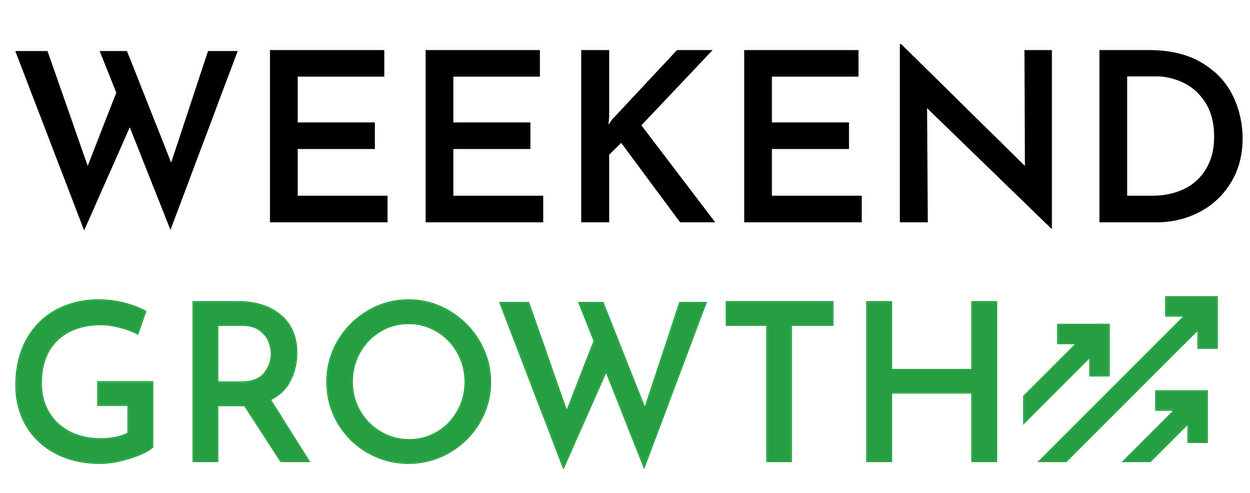Updating content is hard. Writing new content is a LOT easier. But you need to update your content.
Danny Sullivan from Google roasted helped a website owner last week on Twitter analyze an article that appeared to be updated but wasn’t actually. He had other recommendations, but that was the one he really harped on.
But even without Danny picking on this, we know how important it is. The HCU only brought it more to the forefront.
So in today’s post, I’m sharing a way to use AI to help you identify WHAT to update your article with. It takes a few minutes, but it’s easy. I share step-by-step, with plenty of screenshots! 👇
Quick Navigation
ChatGPT for Content Updating Topical Research
I find this works best for articles that are ranking in spots #3 – #8 for your target keyword. This gives you at least a handful of articles you can use to build recommendations from.
Let’s use the query “disneyland genie plus tips”. I just recently went to Disneyland with my family, and had this exact question (omg, that whole Genie+ situation is intense, but that is a conversation for another day).
Let’s use https://tripswithtykes.com/ as our example. They currently sit at #4 for the query. A look at the SERP details shows that they have a strong enough backlink profile to rank higher.

So, previously I would just pop this situation into ChatGPT, and have it analyze the URLs. I used a plugin to do this, and then an update made it so I didn’t have to. Here is the prompt I use:
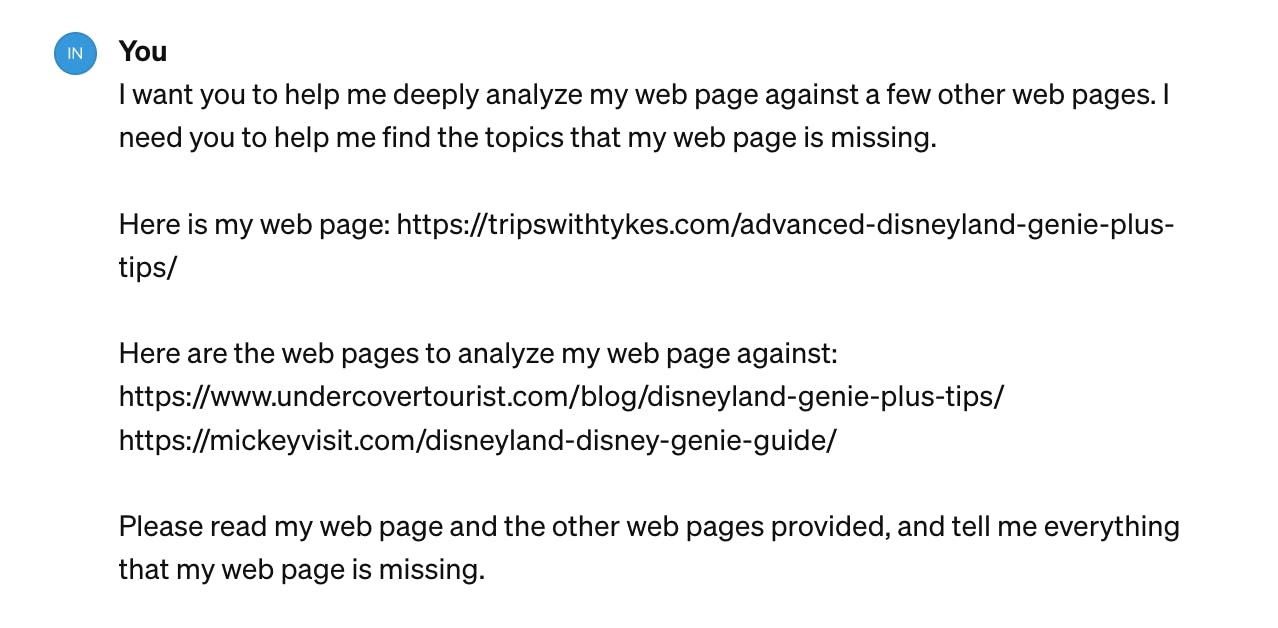
Lately, though, ChatGPT has been avoiding reading URLs… perhaps due to those NY Times allegations? Either way, I end up with statements like these:
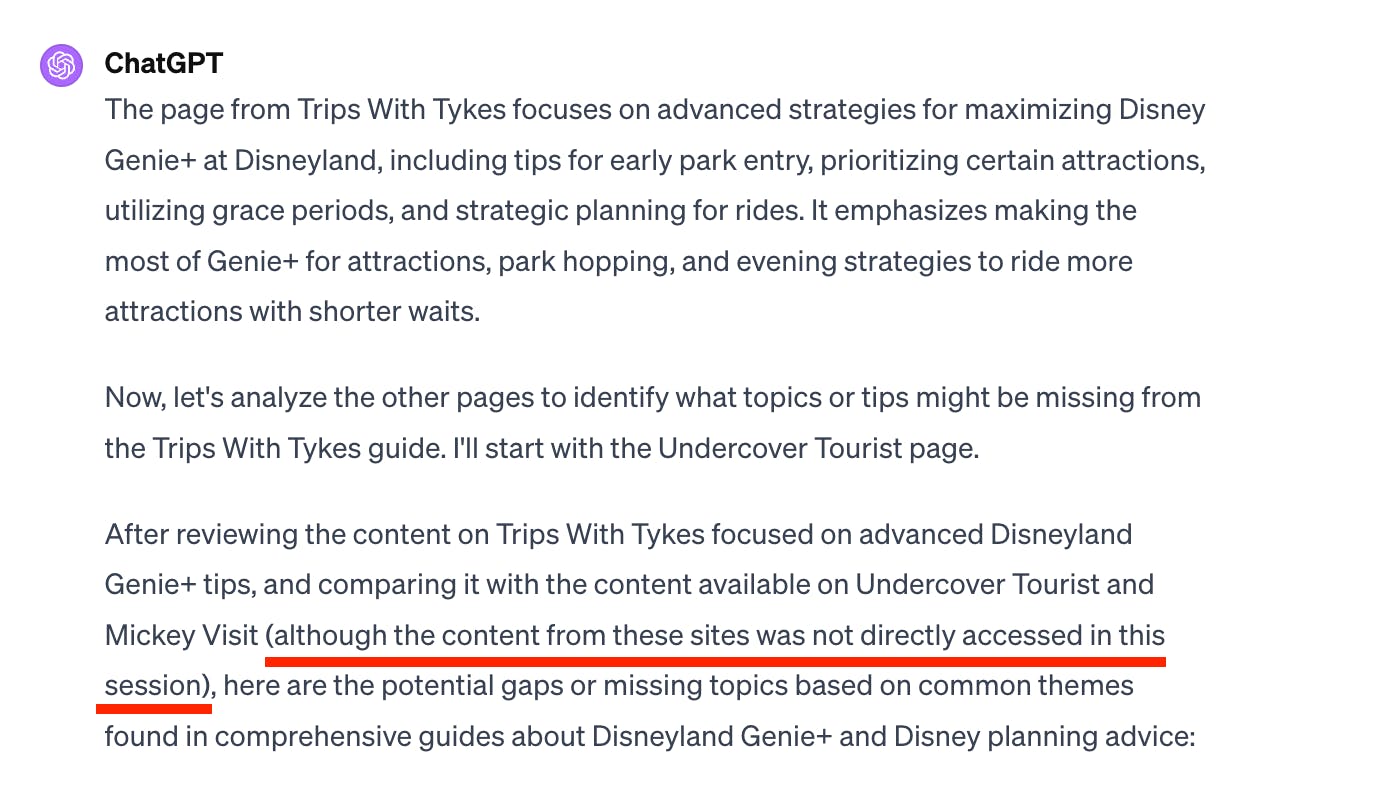
Huh? Well, that sure leaves some ambiguity. Based on the subsequent answer, it sure seems like they know the article. And, that language could be referring to a previous version of the article they have.
Another option, which adds an extra step, is to copy/paste the articles into ChatGPT instead. This doesn’t work well on longer articles, as you hit the token max. It also involves a little bit more work. But, it does guarantee that ChatGPT is truly analyzing the correct content.
For this, here is the prompt framework I use:

I copy and paste the corresponding articles in their respective places. Tip: use the “reader view” mode in Firefox to copy the article. It strips all the menu, sidebar, ads, etc out!
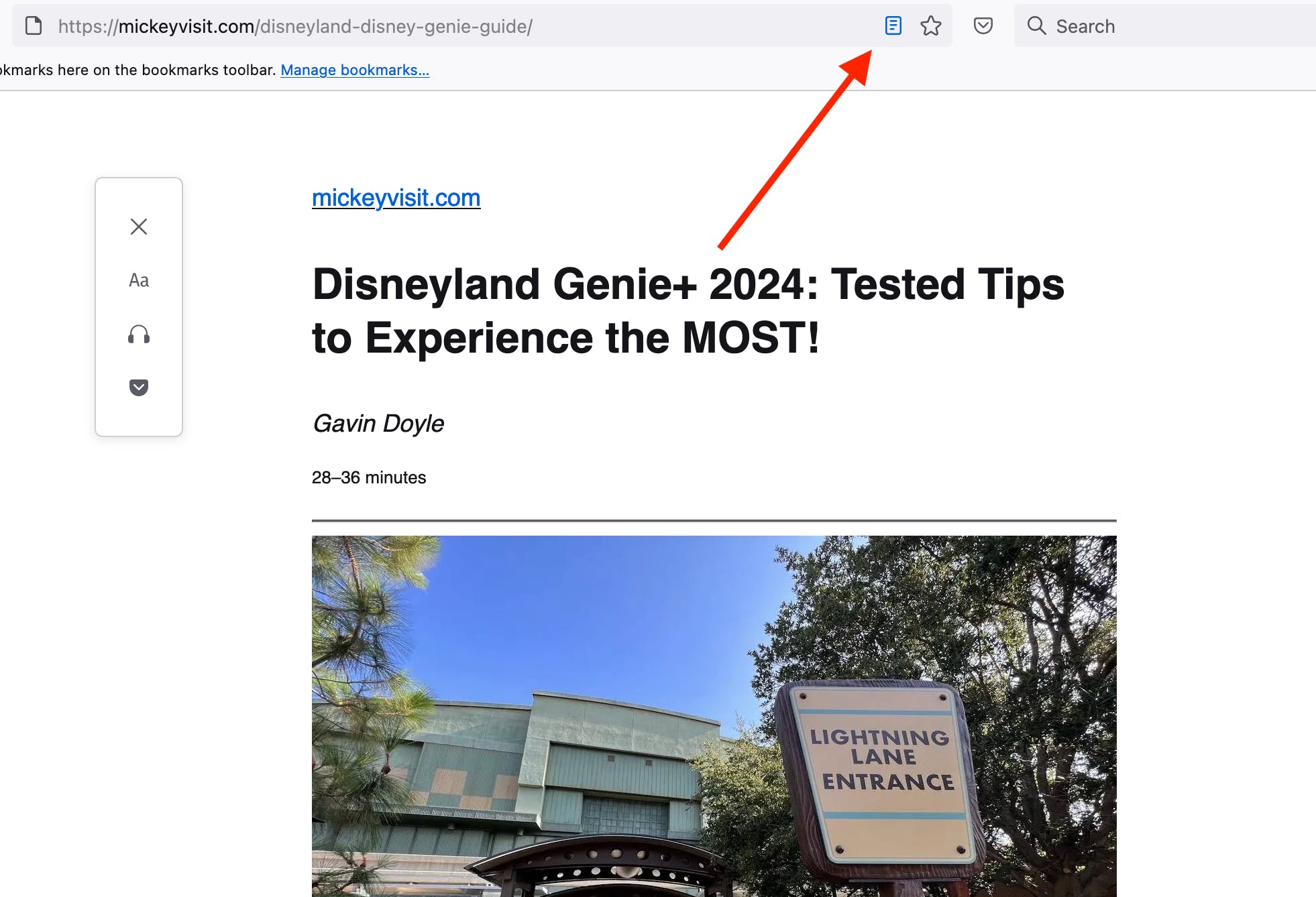
Ok, so let’s look at the results ChatGPT gives:

Alright, that makes me feel more confident. Let’s get into the analysis. First, it dissects what Undercover Tourist covers that my example articles does not:
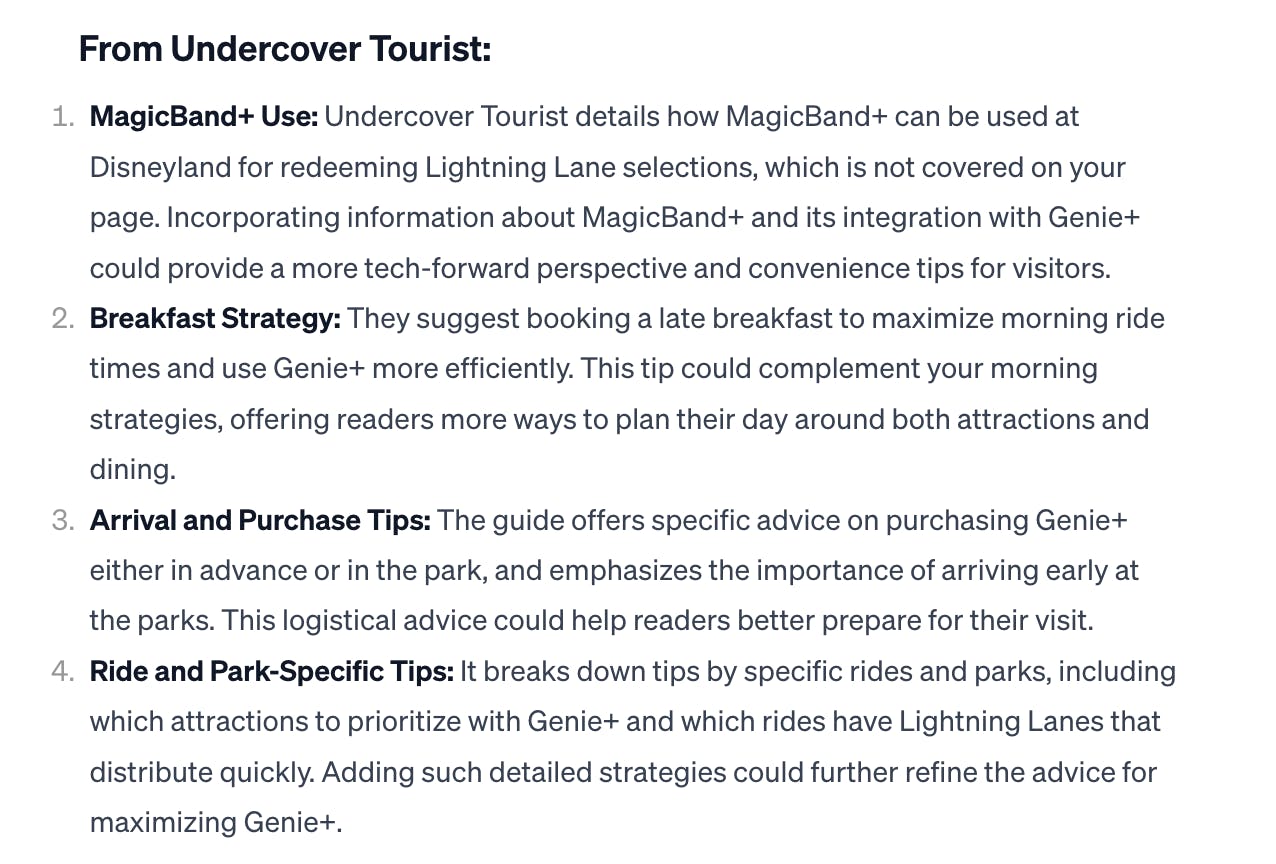
Alright, now that’s good! A few things I’ve learned:
- MagicBand+
- Breakfast
- Genie+ purchase timing
- More detailed strategies
Need help understanding exactly what your website needs to grow? I offer Website Reviews that might be just what you need. See the 5 star reviews from dozens of site owners!
Let’s look at the first thing ChatGPT highlighted: MagicBand+. My example article only mentions it once, and it’s definitely in passing:
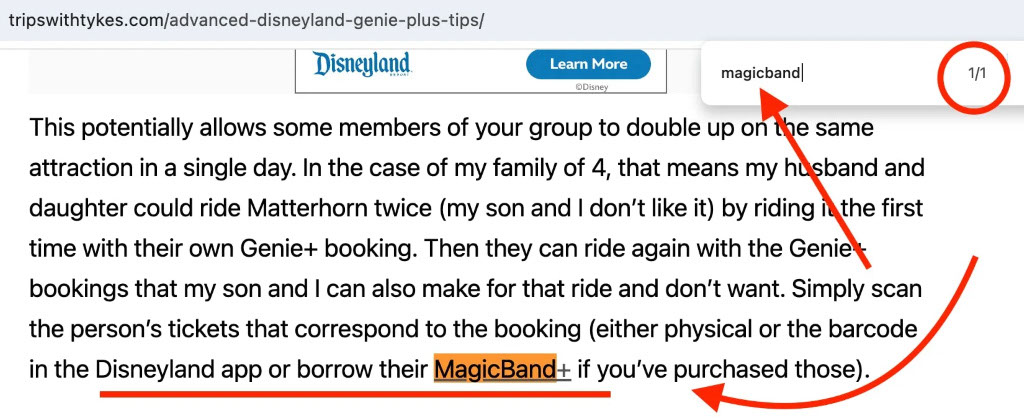
Undercover Tourist doesn’t do much better, but they do tell me WHY this MagicBand+ can help. And, they link to a supporting article that clearly HELPS me as a reader.
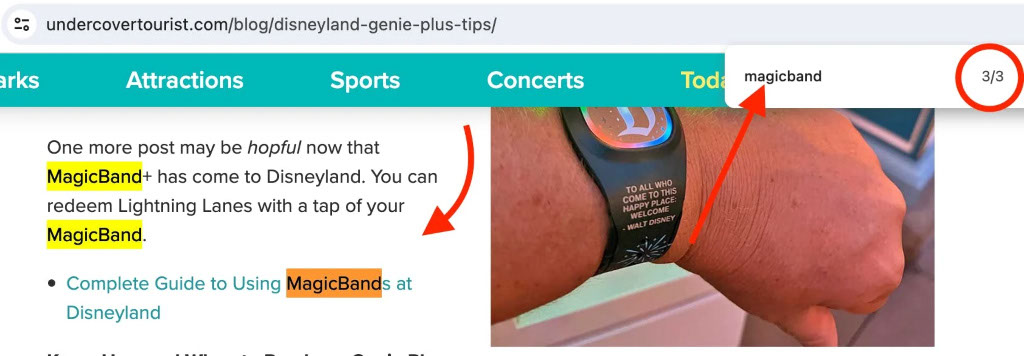
So, I would consider this a great opportunity for me to update my article with.
A similar evaluation of the other topics surfaced:
- Breakfast: my sample article doesn’t mention it once, while Undercover Tourist talks about it 15 times!
- Purchase Times: my sample article doesn’t mention it once, while Undercover Tourist dedicates an entire header and section to this!
This is great. Within a minute or two, I have a really good list of things that articles ranking higher than me include that I don’t!
Now, on to ChatGPT’s final recommendation… Content depth is always hard to quickly analyze. I would say that both have a lot of depth to them, so that would require more of a “Disney expert” to analyze.
But there are LOTS of great tips that ChatGPT found. Topics that my sample article was clearly missing.
Let’s move on to the second article I presented from Mickey Visit.
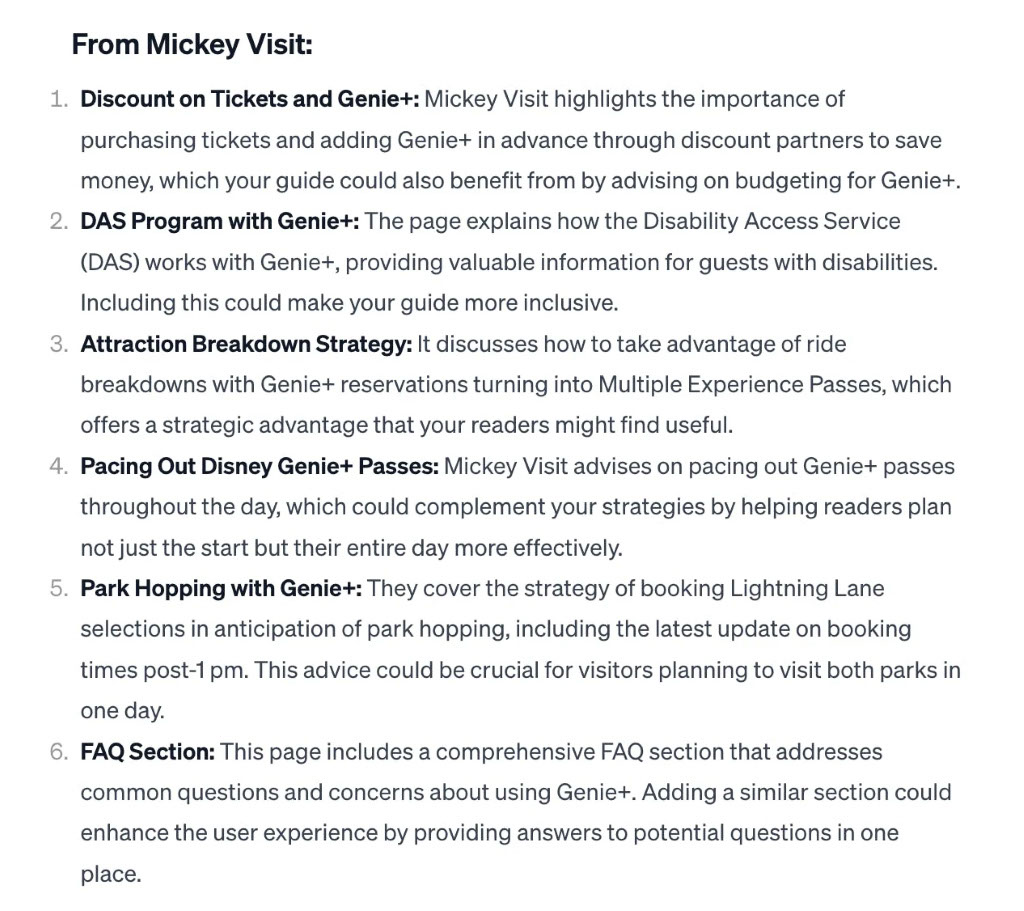
You can go through the same comparative process here that I showed you for the previous article.
It’s important to have an open mind. Let me give you an example. The #5 point from ChatGPT has to do with park hopping with Genie+. If you look at my sample article, it mentions park hopping 15 times.
So, you might be tempted to say, “Well, I covered that, I’ll skip that suggestion.”
But you have to dig a little deeper. The suggestion was park hopping related, but specific to using it combined with a Lightning Lane strategy.
If you go back to my sample article, that specificity is not covered. So, it is a good opportunity, but you have to see a bit deeper than surface level.
Ok, with that process out of the way, I often like to ask ChaGPT to provide me a list of action items:
Here is what it provided me:
- MagicBand+ Integration: Explain how visitors can use MagicBand+ at Disneyland for a smoother experience with Genie+, including redeeming Lightning Lane selections.
- Breakfast and Early Entry Strategies: Suggest strategies for incorporating dining plans, especially breakfast, into the morning for maximizing ride times. Discuss the benefits of early entry for hotel guests and how it can be leveraged with Genie+.
- Detailed Purchase Advice: Offer guidance on purchasing Genie+ in advance vs. in the park, including tips for arriving early and the logistical advantages of having Genie+ pre-loaded on tickets.
- Ride-Specific Strategies: Provide detailed strategies for prioritizing Genie+ selections based on rides and attractions, including which to book early in the day and which can wait until later.
- Disability Access Service (DAS) Integration: Detail how the DAS works with Genie+ for guests with disabilities, enhancing accessibility information.
- Utilizing Ride Breakdowns: Explain how to take advantage of ride breakdowns that convert Genie+ reservations into Multiple Experience Passes, offering a strategic edge.
- Genie+ Pacing and Park Hopping: Discuss strategies for pacing out Genie+ reservations throughout the day and how to effectively use Genie+ while park hopping, including updates on booking times post-1 pm for park hoppers.
- FAQ Section: Include a FAQ section addressing common questions about Genie+, from basic functionality to advanced tips, based on common inquiries.
- Budgeting for Genie+: Offer advice on budgeting for Genie+, including the benefits of purchasing in advance through discount ticket partners to save money.
- PhotoPass Benefits: Highlight the inclusion of PhotoPass downloads with Genie+ and suggest how to make the most of this feature during a Disneyland visit.
- Technology Tips: Advise on keeping phones charged throughout the day, considering the heavy app usage required by Genie+, and recommend carrying a portable charger.
Notice it found 3 additional things my article is missing? Such is the way of AI these days.
But, with that being the case, it’s always good to ask it one final prompt:

And woah… I got a lot more back!
- MagicBand+ Utility: Emphasize how using MagicBand+ not only simplifies the process of redeeming Lightning Lane selections but also integrates with the overall Disneyland experience, offering convenience and streamlining park navigation.
- Early Park Arrival and Strategy: Highlight the importance of arriving early, not just for taking advantage of shorter lines but also for strategizing Genie+ selections and making the most of the cooler morning hours.
- Dynamic Pricing of Genie+: Address the dynamic pricing model of Genie+ and how prices can vary based on demand and season, offering readers insight into budgeting for their trip.
- Maximizing PhotoPass: Since both articles mention PhotoPass benefits included with Genie+, providing creative tips on how to make the most of this feature could add value. Suggest locations for iconic photos or how to plan photo opportunities around Genie+ reservations.
- DAS and Genie+: Deep dive into how the Disability Access Service (DAS) integrates with Genie+, offering actionable advice for guests needing accommodation, thereby making your article more inclusive.
- Ride Breakdown Strategy: Clarify the strategy around ride breakdowns with real-life scenarios or examples, helping readers visualize how to turn an unexpected event into an advantage.
- Park Hopping with Genie+: Elaborate on the logistics of park hopping, especially in the context of making Genie+ selections for another park. Offer scenarios or strategies for smooth transitions between parks.
- Technology Tips for App Use: Beyond advising to bring a charger, offer tips for managing app use throughout the day to conserve battery, like adjusting screen brightness or closing unused apps.
- Morning and Evening Priorities: Given the emphasis on starting early or staying late, offering a sample itinerary that balances morning energy with evening relaxation could guide readers in planning their day.
- Personalized Itinerary Planning: Leverage the Disney Genie app’s personalized itinerary planning feature, suggesting readers input their must-dos to receive customized recommendations that complement their Genie+ selections.
- Interactive Use of Genie+: Encourage readers to actively use the Genie+ feature to modify plans throughout the day, emphasizing flexibility and spontaneity in their park experience.
- Integrating Dining with Genie+: Provide strategies for synchronizing dining reservations or mobile orders with Genie+ selections, ensuring a smooth and enjoyable park experience without unnecessary backtracking or waiting.
These suggestions follow a similar pattern I’ve seen using this strategy in the past… they start to break down a bit. But that’s ok! There is still value here, especially as a great way to brainstorm what additional edits you can make to your article.
You can also ask ChatGPT why it had a specific suggestion. As an example, my sample article had an entire section dedicated to Early Entry. And yet, ChatGPT had that on as #2 on its suggestions.

And, ChatGPT (long-windedly) admits it was wrong:
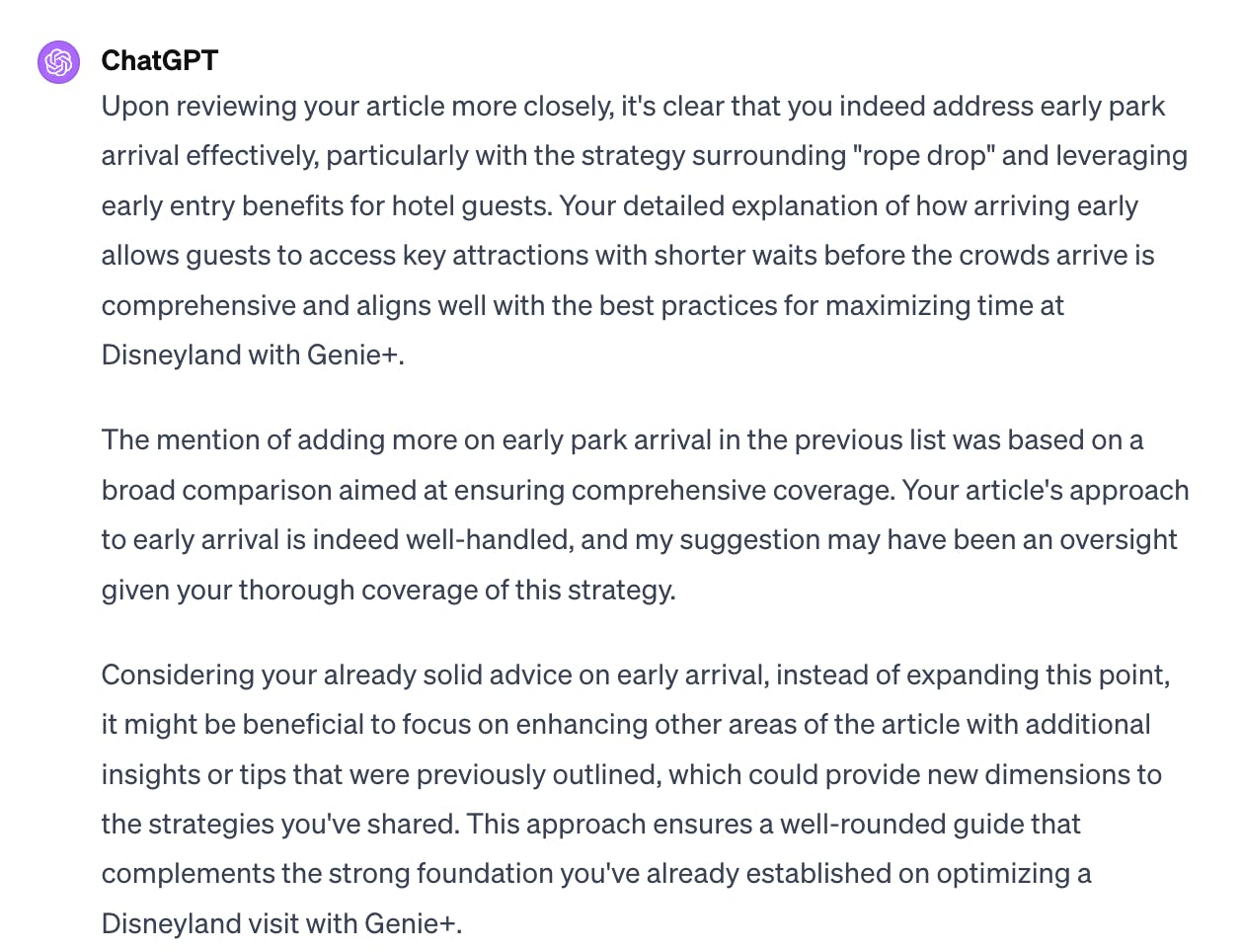
So, there you go – check the recommendations first. But don’t be afraid to ask ChatGPT for more information about why a topic makes it on the list. It does surface great insights sometimes.
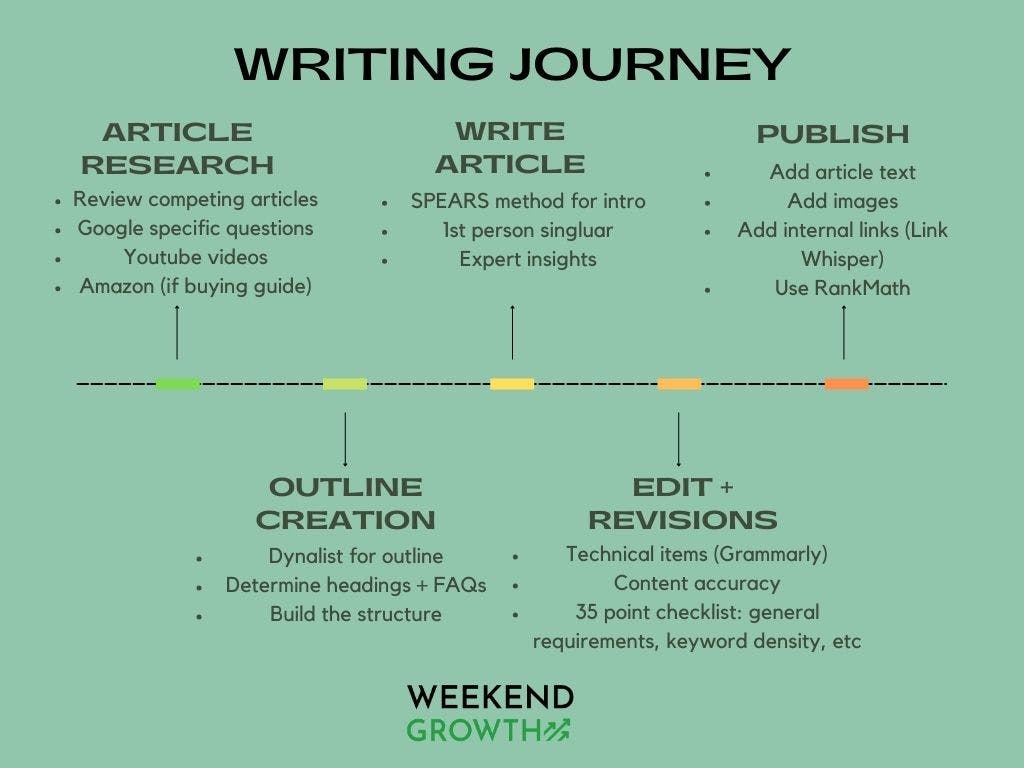
If This All Seems Like a Lot of Work…
It’s because it is. And honestly, it’s only one way you should be analyzing your content for updates that are needed. You should be using other sources in addition.
You should also be adding other unique elements when you update content. Tables, custom graphics, unique images, expert insights, unique perspectives, on-the-ground experiences, etc.
And then don’t forget to update your internal links. This is an important part of creating Topical Authority.
Shameless plug, but I get to make it after showing you so much detail here in this post. My agency has a best-in-class Content Updating service.
We redid the whole process last year, including hiring Tony Hill to consult on our process (have you heard his exact steps for updating content? They’re intense, in a good way). Btw, you can hire Tony to consult for you too, and I’ve gotten you a 50% discount with code JARED (limited to 5 ppl).
It’s the same process that Jon Dykstra hired us to perform on his largest site – you can read more about his thoughts on that. Let’s just say he was impressed.
You can learn more about our Content Updating service here. And, if you want more details about how it applies to your specific website, just reach out!
Content Updating Promo: Through Sunday, February 11th, get a FREE 30 minute consulting session when you book at least 5 URLs of Content Updating service.
Recap
Updating content is hard. It’s necessary to do. You can make the topical research part easier by utilizing ChatGPT. Commit to updating your content!
I hope this article has helped 🙂
